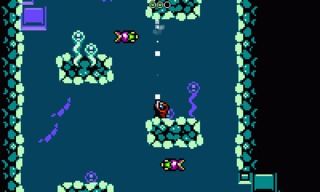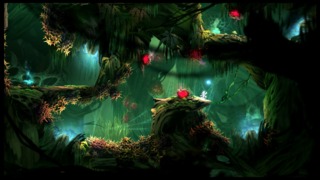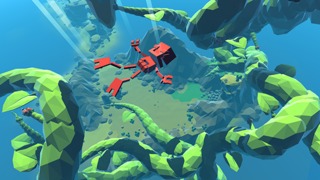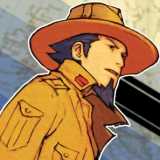Monthly Roundup, March 2015
By majormitch 3 Comments
March was the month where I finally started seeing the light at the end of the tunnel. After a long, busy, and very tough year in grad school, graduation is only a month away. And realistically, most of the work will be done around mid-April. That means some genuine gaming time looms in the not too distant future, but March still carried a heavy workload for most of the month. In fact, I barely played any games at all during its first half. As the second half started to lighten up ever so slightly, however, I was able to sneak in a handful of games here and there. All of the games I played this month were very short, and I’m still having to delay diving into March’s big game (Bloodborne), but hey, games are games. Let’s talk about ‘em!
The Vanishing of Ethan Carter

After hearing all the praise it got at the end of 2014, I’ve had The Vanishing of Ethan Carter at the top of my list for some months now (there’s a “paper trail” of that on this very site). After months of pushing it off for one reason or another, I finally got around to playing it in March. And in an ironic twist that I kind of saw coming, I ended up not really liking it. While the game is absolutely gorgeous (one of the few games I’ve ever played where I stopped to gawk at the scenery for minutes on end), the puzzles and story did not grab me at all. Most of the “puzzles” didn’t have any consistent logic I could identify, which led to me blindly interacting with everything until it worked. At different times this involved both “pixel hunt” type situations (not in the literal sense, but you get the idea), and pure trial and error. The latter primarily occurred when trying to piece together the chronology at the end of each puzzle, as those sections felt very arbitrary to me. I therefore found all of the gameplay very unsatisfying, and the story didn’t fare any better. It was a supernatural murder mystery of sorts, but the way it laid everything out felt very soulless and meaningless to me. I never acquired more than a baseline understanding of what was going on, and the understanding I got was not interesting in the slightest. It just didn’t have any punch to it, which is really what I could say for the entire game. The Vanishing of Ethan Carter sure is pretty to look at, but I can’t say I’ll remember it fondly for any other reason.
Xeodrifter

I played through Xeodrifter this month, which didn’t take but 2-3 hours. I was interested in this game when I first saw it at the end of last year, as it seemed like a bite-sized exploration focused game that nonetheless had some real substance to it. That’s pretty much what it is too, and I quite enjoyed it. Despite its brevity, I think it does what it sets out to do very well. It keeps up the pace from start to finish, the levels are well designed and fun to explore, and the upgrades you regularly get feel meaningful. They gave me that sense of constantly becoming more capable of surviving in the world around me, and looking for extra power-ups was pretty satisfying as well. I enjoyed the iterative boss design too; each boss in the game was the same basic creature, but every time you fought it saw it gain new, more powerful tricks. That created a neat and consistent through-line for the game that glued it all together. I also enjoyed the art style and music, but the one thing I didn’t care for as much was some of the combat and enemy design. Much like Mutant Mudds before it, combat mostly boils down to standing and shooting a creature in a dull rhythm, while jumping over the occasional counter fire. Some later enemies are a little more interesting and demand more dexterity, but the real issue is that many enemies are big bullet sponges. It wasn’t uncommon for me to rotely shoot through a series of nonthreatening enemies for 5-10 seconds each, which gets old fast. Other than the somewhat lackluster combat, however, I think Xeodrifter is a nifty little game, and worth a look from anyone who likes an exploration focused action game.
Ori and the Blind Forest
Ever since I saw the debut trailer for Ori and the Blind Forest, my interest was piqued. The game looked and sounded absolutely incredible right out of the gate, and it seemed to have some tight platforming to boot. All of those initial impressions proved to be correct, which is a rare and wonderful thing when it happens. I played through Ori in its entirety during March, obtaining practically 100% (more on that in a minute). Needless to say, the game’s presentation is outstanding. You really have to see it in action, but the way the art moves on screen is a sight to behold, and really imbued a lot of personality and life into the whole experience. The soundtrack is just as good as the visuals, if not better, and it comes together to convey a surprisingly touching narrative. I found it easy to become invested in the game’s happenings, and willingly let it guide my emotions from start to finish. That said, this is very much a gameplay focused game above all else. Ori is driven by some tight, action heavy platforming, which could get satisfyingly tough in a few spots. There was only one sequence near the end that I found frustrating, but Ori’s platforming otherwise felt great to me. It formed a rock solid core that I never got tired of engaging with.

What wasn’t apparent from that initial trailer, however, was Ori and the Blind Forest’s exploration aspect. Or, to resort to the overused description, how “Metroidvania” it is. That word is falsely mentioned so often that it’s practically lost all meaning at this point, but in the case of Ori the sentiment is mostly accurate. The game has a sprawling 2D world with all sorts of nooks and crannies, and its many different paths and areas weave back in on themselves frequently enough to make the world feel like a single interconnected space. You acquire new abilities as you progress, which compliment your platforming to allow you to access new areas, or empower you to better combat enemies. There’s also experience points to be gained and spent on a skill tree, and tons of collectibles to find that include health upgrades, energy upgrades (for saving and special moves), and large experience pickups. All in all, I think the exploration and upgrades are handled very well. It may not be as intricate or sharp as, say, Super Metroid, but Ori does that stuff noticeably better than most games have in a long time. I for one enjoyed poking and prodding at every part of the game’s large, diverse map. One side comment that doesn’t apply to just Ori, is that I’m not sure how much I like the modern trend of games with important collectibles eventually showing you their location on the map. I understand the frustration of retreading the entire world for that one last collectible (trust me on that one), but at the same time collectibles feel even more like busy work when it’s all mapped out for you. I’m not sure what the answer is, but I feel like there should exist a better balance on that stuff.
My only substantial gripe with Ori and the Blind Forest, however, is that there are missable collectibles and upgrades in the game; that seems downright criminal in a game so focused on exploration. Not only that, but once you beat the game you can’t load your file back up at all. It still sounds completely crazy, but once you beat the game you can only play more Ori by starting a new file. I have no idea if this was a design choice or a massive oversight (or if it may be patched later), but either way it’s super lame, and will drive any completionist nuts. Fortunately for me I knew that ahead of time, and was prepared to just let some items go. As far as I can tell I only missed a single item, which was a permanently missable energy orb . That was a little annoying, but I quickly let it go and moved on, accepting my experience. And on the whole, it was a wonderful experience that I would recommend to anyone who likes strong 2D platforming and/or exploration. The sweet presentation doesn’t hurt either, and the result is a beautifully complete package that delivers on all fronts.
Grow Home

Grow Home is a game I just want to hug. It’s so gosh darn cheerful about everything it does; it has that joie de vivre about it that I always wish more games had. And while it’s not perfect, it’s a pretty fun game to play as well. The gameplay primarily boils down to collecting crystals and climbing a giant plant, never getting any more ambitious than that. In some ways it reminds me of very early 3D platformers on the Nintendo 64 or PlayStation, in the way that they were primarily about roaming a 3D space and picking stuff up. Grow Home is a similarly simple game (maybe even simpler than those games), but maintains the same positive spirit. And truth be told, the climbing can be pretty fun. The way you can stick to just about anything, holding on as you alternate one hand over the other, can be pretty mesmerizing in spots. It can also be kind of dull after a while, and there came a point where I grew tired of slowly and tediously climbing a giant formation looking for another trinket. The frustrating camera was the worst part of it, as I frequently had issues trying to look around to see where I needed to go. Less of an issue, but an issue nonetheless, was you character B.U.D.’s movement. Billed as “procedural animation”, I found it prone to just spazzing out here and there. I’d become oriented in a random direction, or sometimes just straight up fall down unprompted. I’m not sure what the benefits are of doing movement that way either, which made it feel like a fancy tech demo as much as anything. In fact, that’s almost how I feel about Grow Home on the whole. It’s short, cheap, has a few neat ideas, but still feels too lacking in some key areas to be a complete thing. It’s got some real heart to it, and the low barrier to entry makes it totally worth a shot, but Grow Home is really a simple collectathon more than anything. I’m not sure how much it will stick with me as a result.
The Other Stuff
- I tried Crypt of the NecroDancer with a dance pad this month. Naturally, playing with a dance pad made things a lot harder, and that’s even playing on the dance pad (ie., easy) difficulty. I’ve played a lot of DDR over the years, and consider myself pretty good at it, but maneuvering around and reacting to a randomized dungeon is another beast entirely. It was kind of fun though, and I’d like to play it that way some more; it’s a good challenge, and in a way makes the game more interesting to me. Crypt of the NecroDancer is perfectly fine with a controller, but I’m not one to get super into such games, and adding that physical workout to it may get me to come back more often.

- I went back to OlliOlli (the original) this month, and made my way through the rest of the levels. I ended up ignoring the challenges for the sake of simply finishing the levels, as I have no interest in chasing high scores. That’s probably missing the point entirely, but it just didn’t grab me enough to want to dive that deep. I will say I got more used to the controls as I played, and I think it’s a neat game for those who want a very involved, technical skateboarding game that they can perfect and chase high scores with. That’s not me, but it was still a neat game to see. Who knows, I may check out the sequel someday.
- I played through the entirety of Gunman Clive in about an hour, which I had gotten for a dollar or so in an eShop sale. It’s a pretty bare bones platformer/shooter, kind of reminiscent of the old Mega Man games in a way, just with a lot less meat to it. It made for an enjoyable enough hour, but I’ll admit I wouldn’t care to play more of it. I’ve played enough similar games that do something interesting past the basics, and I don’t even know that Gunman Clive did the basics all that well; the controls felt kind of stiff to me. I did enjoy that game’s style though, for what that’s worth.
- I’ve been playing HarmoKnight as March comes to a close, which is a simple eShop rhythm game from the Pokemon folks. I’m a sucker for weird Japanese rhythm games in general, and I couldn’t resist the temptation to drop my Club Nintendo coins on it when presented the option. At any rate, you control a character moving across a side-scrolling screen, attacking and jumping in rhythm with the beat. It’s nothing new or complicated, but it’s executed well enough, and has some welcome challenge to it. It also has a goofy but likable personality, and that’s probably the main thing that’s keeping me going. That and the Pokemon themed bonus stages. Otherwise the game’s almost too simple to really stand out, but it’s not a bad time by any means, and has been a solid pick-up-and-play title as I wrap up some big school projects.
Looking Ahead to April
The two March releases I was most eager to play were Bloodborne and Axiom Verge. I simply didn’t have time for Bloodborne during March, and Axiom Verge only came out on the last day of the month. Needless to say, that pair of heavy hitters is right at the top of my list for April. I’ll tackle Axiom Verge first, and if school lightens up the way I expect it to, I just may be able to dive into Bloodborne as well. Otherwise I have a lengthy backlog as always, which is currently led by The Talos Principle, and there are a few games of interest coming out in April. Titan Souls, Mighty No. 9, and the second act of Broken Age are all due for imminent release, and I’m curious how each turns out. I have plenty of gaming options, that’s for sure, and here’s hoping I can find some solid gaming time during this final month of school!

3 Comments